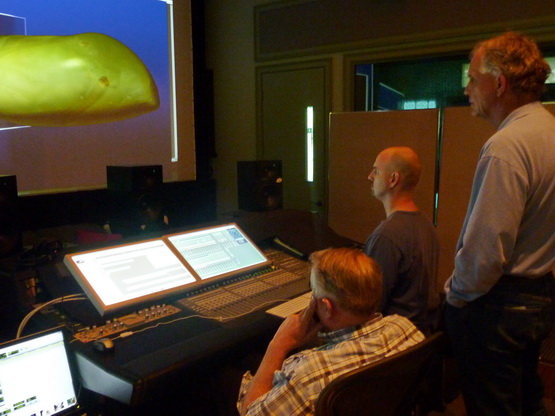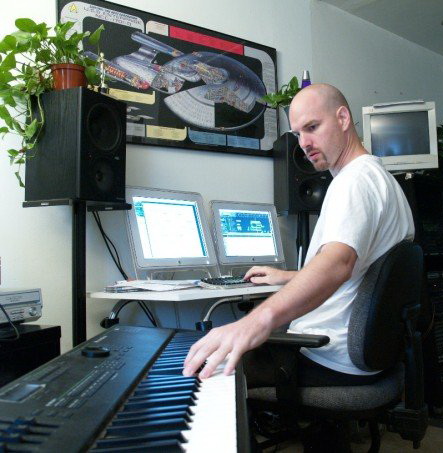 Culture & Ethics
Culture & Ethics
Intelligently Designing Music to Match Butterfly Magic
One of the things that grabs your attention in the very first seconds of Metamorphosis, the new documentary from Illustra Media about butterflies, is the music. The vibrant voices of an African choir superimposed on a dynamic orchestral score explodes into a celebration of life, worthy of the opening majestic scenes of nature. From there onward, the music, at times pensive, at times effervescent, maintains its perfect match to the visuals to the end of the final credits, sending the viewer soaring above the scientific facts into a joyful, thoughtful, emotional adventure from start to finish.
 Like any intelligently-designed product, this doesn’t just happen. The wrong sounds could be disastrous. We interviewed composer Mark Edward Lewis and asked how he did it — how he achieved the perfect score for Metamorphosis.
Like any intelligently-designed product, this doesn’t just happen. The wrong sounds could be disastrous. We interviewed composer Mark Edward Lewis and asked how he did it — how he achieved the perfect score for Metamorphosis.
Mark, how long have you done music for Illustra films?
Lad Allen is an excellent director I have worked with for over 20 years. At last count, I believe I’m reaching 50 projects that I’ve scored for him, the latest being music for a promotional video about their next project, which will be shown at this weekend’s Metamorphosis premiere in California. Illustra films have musical underscore during 90% of the picture. So, in a 60-minute film, there will be over 50 minutes of music. Lad and I have developed a verbal “short hand” about the genre, style and emotion that music should have in a scene. I watch the movie at my studio, he sends me meticulous notes, we talk about them over the phone, and that’s it! The partnership works very well.
How does your creative process work when you begin to fit music to the film?

For me, the creative process begins when I have my first conversation with Lad about his creative vision for the movie. We talk about where the music should go and not go. Once I have Lad’s thoughts and a list of musical numbers or “cues,” I watch the current version of the edited film (which is never in a completed form). I then sit down at my piano and work out themes. It is important for me to work out the “through line” of the soundtrack with melodic and harmonic themes before I think about anything else. I find that working out themes at a giant instrument filled with wood and steel (my piano), as opposed to a digital keyboard, brings the best and most poignant results. The themes are the lifeblood of the soundtrack. They are the glue that holds all the various fabrics of a score together. They also keep me from having writer’s block! In a typical Illustra film, we will have two themes at minimum. For Metamorphosis, we have the main theme and a “building” theme. There is also the lyrical/vocal theme for the “building” theme that is used separately.
How do you start arranging the themes to match the ever-changing images on screen?
Once I have composed themes and Lad has approved them, I write in chronological order, because the first portions of the movie are the only portions that are “picture locked” by the time I start work. I examine the opening cue, and I notate all the points that occur to me to be important visual places to “hit” with music: a hard cut, a title, an important point from the narrator, etc. Then, I watch the scene I’m scoring and watch the rhythm of the visual scene and only listen to the narrator. There is always an inherent tempo that works for a scene (sometimes more than one). Once I find it, I massage the tempo, sometimes within hundredths of beats per minute, to align to the frame with all the visual and narrative “hits.” Of course, sometimes there’s more than one tempo or time signature within a cue, which can further complicate things.
How do you choose the instrumental colors to fit the cue?
Once this “tempo map” is created, I determine if any of the themes will be used in the cue, what the general genre of the music will be, and if there are any special instruments that I need. I plot those elements into my rough sketch, and I will search for digital instruments that make a good facsimile of the real special instrument. Once I find a suitable sound, I load it into my digital orchestral template. Sometimes finding the right instrument can take hours, and sometimes I have to design it from scratch. After all this, it’s finally time to get writing the cue! I usually start by performing the parts that are the most musically developed in my head. This could be percussion, strings, woodwinds, synths … anything that I know needs to go into the cue. Once those parts are successfully performed, I begin experimenting with how to lift the cue to a higher level both sonically and musically. Sometimes this means counter melodies, production or additional orchestration, or just simple mixing tricks and effects. Generally, I know I’m not finished with a cue unless it meets the emotional standards of the director and my high standards for music and sonic quality.
How did Metamorphosis differ from your earlier Illustra soundtracks?
 The Metamorphosis score has the benefit of several potent assets that have never existed in any other Illustra score. As the case with all of the scores for Illustra Media, they are predominantly produced without any live musicians. Everything is done “within the box” as we say or completely from within a computer. Samples, software, and my performances at the keyboard comprise the audio tapestry nearly in total. As a result, the quality of the digital instruments used directly affects the quality of the score. For Metamorphosis, I was blessed with one of the world’s finest orchestral string instrument libraries. As a cellist myself, I have been somewhat disappointed with digital string libraries, and I have spent countless hours slaving over creating realistic string writing with digital instruments. Sadly, the writing and orchestration become slave to the inhuman and sometimes unforgiving string sounds. Not any more. This new library allowed me to use all of the string creativity I could muster for the film, and I had nearly no limitations. It was like having a real string orchestra at my fingertips, and both Lad and I agreed that we could not have attempted a project as ambitious as the score to Metamorphosis without this incredible string sample library.
The Metamorphosis score has the benefit of several potent assets that have never existed in any other Illustra score. As the case with all of the scores for Illustra Media, they are predominantly produced without any live musicians. Everything is done “within the box” as we say or completely from within a computer. Samples, software, and my performances at the keyboard comprise the audio tapestry nearly in total. As a result, the quality of the digital instruments used directly affects the quality of the score. For Metamorphosis, I was blessed with one of the world’s finest orchestral string instrument libraries. As a cellist myself, I have been somewhat disappointed with digital string libraries, and I have spent countless hours slaving over creating realistic string writing with digital instruments. Sadly, the writing and orchestration become slave to the inhuman and sometimes unforgiving string sounds. Not any more. This new library allowed me to use all of the string creativity I could muster for the film, and I had nearly no limitations. It was like having a real string orchestra at my fingertips, and both Lad and I agreed that we could not have attempted a project as ambitious as the score to Metamorphosis without this incredible string sample library.
It’s hard to imagine any of the orchestral sounds coming from a computer. They sound so authentic and natural. What about the vocals? Those were clearly the real thing!
Lad and I made the creative choice to embody the emotional elements of the amazing journey of the Monarch butterfly with African percussion and vocals. It was a very difficult decision, since loud African vocals and percussion underscoring flittering delicate butterflies has little precedent in cinema. We were not convinced that the concept was right for the film until 72 hours before the vocal sessions! We both had faith and felt something in our guts that this obtuse choice would reveal spectacular results. For a composer, there are few better rewards than trying something musically which makes no sense “on paper” but just “feels” right … and, then, having it turn out as gold. In my entire career, the success of African music with butterflies stands as a prime example of this kind of wonderful faith in the collaborative process of music.
Thank you, Mark. One favorite moment of ours is the scene where scientists discover the hiding place of the Monarch butterflies. With thousands of butterflies dancing across the scene, the music is so joyful, so rapturous, it deserves a standing ovation right then.
============
In our concluding installment of this interview with composer Mark Edward Lewis, we will hear more about the singers (and try to figure out what they are saying as they sing) as we take more exclusive looks behind the scenes at the making of this “intelligently designed”  film on intelligent design.
film on intelligent design.
Turn your copy of Metamorphosis into a concert! You can find the best of Mark Edward Lewis’s score in the Bonus Features, where you can play them through your surround-sound stereo system. Visit Metamorphosisthefilm.com, where you can watch the trailer and order this outstanding documentary, now available in both DVD and Blu-Ray formats.
